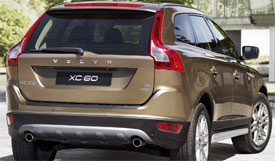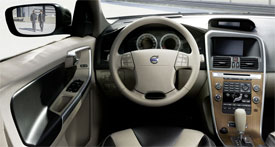2010 Volvo XC60
For more than a generation, Volvo has built its American reputation on two things: safety and its premium station wagons. Even when wagons fell out of favor at other brands, they remained an attraction for Volvo purists. But, some of those fans did defect to the Volvo XC90 Crossover. Now, with the all-new XC60, it’s possible that a lot more just might be tempted to follow suit.
The 2010 Volvo XC60 may be a late entry into the premium compact-to-midsize crossover race, but don’t expect this stylish and sporty utility to trail behind for too long.
The XC60 will compete directly with the BMW X3, the Acura RDX, and the Mercedes Benz GLK.
Styling hints of the XC70 and XC90, but from there the familiar Volvo DNA runs a little wild. The modified trapezoidal grille is flanked by dramatically flared headlamps.
The XC60’s wedge-like forward-leaning profile makes this crossover look like it’s ready to pounce. A muscular shoulder line, lower body cladding, and a coupe-like greenhouse all add to its athletic presence, as do the 18 or 19-inch wheels.
Further distinction comes from a well-sculpted back-end. But the most eye-catching cue is, no doubt, the exaggerated boomerang-like LED tail lamp design.
Offered currently as a single T6 all-wheel-drive model, the XC60 is moved by Volvo’s familiar 3.0-liter turbocharged inline-6, producing 281 horsepower and 295 pound-feet of torque. Max towing capacity is a reasonable 3,300 pounds.
 Power is managed by a six-speed automatic with manual mode which feeds Volvo’s latest Haldex 4 all-wheel drive system with Instant Traction torque transfer. For the more adventurous, Hill Descent Control is also available.
Power is managed by a six-speed automatic with manual mode which feeds Volvo’s latest Haldex 4 all-wheel drive system with Instant Traction torque transfer. For the more adventurous, Hill Descent Control is also available.
But this wouldn’t be a Volvo road test without a truly novel safety breakthrough. That would be Volvo’s City Safety System. City Safety is a low-speed rear collision avoidance system that utilizes an infrared laser in the rear view mirror to detect a stopped car ahead. City Safety will automatically apply the brakes at speeds up to 18 miles-per-hour to prevent a crash.
We don’t recommend you trying City Safety out just for grins like we did since it doesn’t activate until the last possible second. And stops are quite abrupt and really get your attention.
At the track, the XC60 also impressed us with its quickness. 0 to 60 in just 6.7 seconds and the quarter-mile in 15.2 seconds at 97 miles-per- hour. This crossover has a strong, smooth pull all the way up to the redline. Shifts, however, were not as quick as we would have liked them to be.
Sharing some chassis elements with the V70 and S80, suspension is front MacPherson strut/rear multi-link, with a three-mode active chassis option coming later. Aiding cornering now is an enhanced Dynamic Stability Control System, Roll Stability Control, and for towing maneuvers, new optional Trailer Stability Assist.
Maybe we expected too much, since this is a luxury car, but ride definitely rules over handling. The XC60 exhibits a top-heavy feel and reached its limits somewhat quickly.
Braking redeemed the XC60. Four-channel all-disc ABS with Brake Assist delivered average stops from 60 of a short 127 feet. They were solid and straight with minimal nose dive.
On everyday roads, the ride was soft and plush, perfect for Monday-through-Friday commutes. But with 9.1 inches of ground clearance, taking the XC60 off the pavement for a weekend adventure does not have to be a second thought.
 The interior of the five-passenger XC60 is a continuation of the clean and modern Scandinavian design we liked so much in the XC70 and C30. Gauges and controls are smartly laid-out and exude an artful sophistication.
The interior of the five-passenger XC60 is a continuation of the clean and modern Scandinavian design we liked so much in the XC70 and C30. Gauges and controls are smartly laid-out and exude an artful sophistication.
The XC60’s seats are well-contoured and supportive, featuring stitched seams and optional heat.
The slim, floating center stack design includes an available navigation screen that’s slightly angled toward the driver. It includes real-time traffic, and remote control.
There’s also a Rear Park Assist Camera packaged with the Nav system.
And not to be forgotten, our tester’s upgraded Dynaudio Premium Sound System with surround sound, for memorable listening enjoyment.
Other characteristic Volvo safety gear includes six airbags, anti-whiplash seats, and optional Lane Departure Warning.
The rear bench seat is fit for three, but it’s not the most spacious we’ve seen. Its 40/20/40 split, however, is family friendly, as are a pair of optional integrated child booster seats.
Cargo room is a generous 30.8 cubic feet with the seats up, and a very competitive 67.4 with the seats down.
Government Fuel Economy for this crossover is an underwhelming 16 city/22 highway on premium gas. We managed to get 20.6 miles-per-gallon in real-world driving.
Base pricing for the XC60 starts at $38,025. That’s less than a BMW X3, but more than the Acura RDX and the Mercedes-Benz GLK.
The eye-catching 2010 Volvo XC60 offers everything an upscale family could wish for - innovative safety, strong performance, true multi-purpose capabilities, and a comfortable, sophisticated cabin. For a company steeped in the tradition of the station wagon, the XC60 is a nice step up that doesn’t’ forget its roots.
Specifications
- Engine: 3.0-Liter Turbocharged Inline-6
- Horsepower: 281
- Torque: 295 Lb Feet
- 0-60 MPH: 6.7 Seconds
- 1/4 Mile: 15.2 Seconds @ 97 MPH
- 60-0 MPH: 127 Feet
- EPA: 16 MPG City/ 22 MPG Highway
- Mixed Loop: 20.6 MPG
2024 Polestar 2
More Range And More Power For The Polestar 2
Volvo is well on their way to making the transition to an all-electric brand, but their sister-brand Polestar is already there. Now, we’ve spent lots of time in their all-wheel drive, five-door Polestar 2, having tested it in 2021, and a year later when a two-wheel drive version arrived. But, EV updates are coming quickly. So, let us be your guide for all that’s new with the Polestar 2.
While we are driving more EVs than ever, we’ve also been spending a lot of time recently circling back to ones we’ve previously tested. As in this new era of electrified vehicles, significant updates are arriving quickly, with R&D investments increasing and retrofitting them easier than ever. This is often done through software updates that can even be accomplished over the air. For 2024, the Polestar 2 has indeed gotten some software updates, but some physical ones as well.
Clearly aimed directly at Tesla’s Model 3 when it arrived; the Polestar 2’s build quality was vastly better, but range definitely came up short. So, addressing that was priority No. 1; and for ’24 the Polestar can travel up to 20% farther than before while consuming 9% less energy, and when it comes time to charge it back up, it can do that 34% faster too.
Range in the Single Motor version increases from a max of 270 to 320 miles thanks to a larger 82-kWh battery pack, and that solitary motor now powers the rear wheels, not the front wheels. It’s also bigger, coming in at 220 kW compared to the previous 170 kW front-wheel drive version, going from 231 to 299 horsepower.
Dual Motors keep the same 78-kWh battery, but still sees a boost from 260 to 276 miles and takes advantage of the larger rear motor for a new combined 310-kW output with 421 horsepower. Our test car has the added Performance Pack, which uses an additional 35 kW to deliver 455 horsepower and 546 lb-ft of torque, though max range drops to just 247 miles.
The new battery in rear-drive 2s will also charge faster, now accepting up to 205 kW for an 80% charge in 20 minutes; max for dual-motors stays at 155 kW, which puts an 80% charge at 34 minutes. Using 32 kWh of electricity per 100 miles, the Dual Motor earns a good efficiency rating.
The [Polestar] 2 has always been one of the most enjoyable EVs to drive, even more so now with that additional power coming from the rear motor.
Unfortunately, extremely cold temperatures kept us from seeing that increased range, as we were only on pace for about 194 miles in our test.
The 2 has always been one of the most enjoyable EVs to drive, even more so now with that additional power coming from the rear motor. And especially when equipped with the Performance Pack as it not only includes more power, but adds 20-inch forged wheels, upgraded brakes, and adjustable Ohlins Dual Flow Valve performance dampers. It greatly improves handling prowess without affecting ride quality, and is easily worth the $5,500 charge if you at all enjoy driving.
Even on a 20-degree track day there was plenty of grip through our handling course. No understeer or oversteer, and lots of feedback through the wheel. There was a nice, strong launch off the line that properly planted us firmly in the seat, and rocketed us to 60 in 4.5 seconds. Power delivery stayed pretty intense up until about 80 mph when there was a definite tapering off. Still, it was a 13.4-second quarter-mile at 102 mph; smooth, quiet, and stable the whole way.
When this car debuted, its Google-based infotainment setup was a novelty, but since then, more and more manufacturers are just “Googling it” so it doesn’t seem out of place at all. The wireless phone charger is easy to access, and there’s a great Harmon/Kardon sound system and panoramic sunroof to enhance the in-cabin experience. Exteriors have also been enhanced with a smooth grille insert and new wheel choices.
Hatchback practicality means 14.3 cu-ft of easy to access cargo space with split-folding seatbacks for longer items and expanding the space to 38.7 cu-ft. Plus, there’s even a sizeable storage bin up front under the hood.
Single Motor Polestar 2 pricing now starts at $51,300, with Dual Motors starting at $56,700; topping out at $64,400.
For a car manufacturer that hasn’t even been around for a decade yet, Polestar has kept itself busy, totally transforming their latest model in just a few years, making the 2024 Polestar 2 even more appealing. They are certainly off to a good start, and with a host of Polestars just over the horizon, including some all-important utility vehicles, this star will be shining even brighter.
Specifications
As Tested
- Motor Setup: Dual Motor
- Horsepower: 455
- 0-60 mph: 4.5 seconds
- EPA Range: 247 miles
- Efficiency : 32 kWh / 100 miles
- Battery Size: 78-kWh
- Torque: 546 lb-ft
- 1/4 Mile: 13.4 seconds at 102 mph
- MW Test Loop: ~ 194 miles
- Peak Charging Rate: 155 kW











































